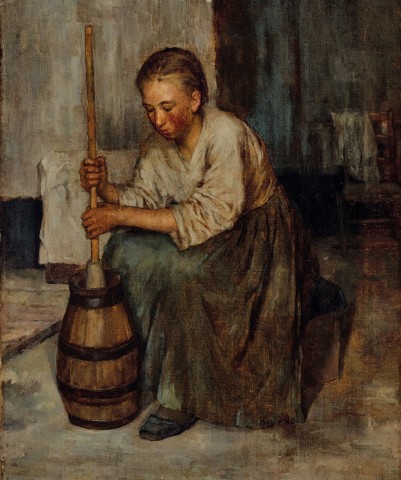PORTRAIT OF A CHILD, c.1889
FLORENCE FULLER
oil on canvas
61.0 x 50.0 cm
bears inscription on frame verso: Portrait of a Child Florence A. Fuller
Robert Law, Melbourne, acquired in the 1890s
Thence by descent
Private collection, Melbourne
Winter Exhibition, Victorian Artists’ Society, Grosvenor Galleries, Melbourne, 4 May 1889, cat. 88
‘Winter Exhibition of the Victorian Artists’ Society’, The Argus, Melbourne, 15 May 1889, p. 9
Florence Fuller was acclaimed as an art prodigy in mid to late 1880s Melbourne. She came to attention initially for completing unfinished portrait commissions after the premature death of her uncle, major late colonial artist, Robert Dowling, and opened a professional art studio in Melbourne before she was twenty. Between 1886 and 1892, her figure work and genre subjects were greatly admired, although reviewers equally credited her for plein air landscapes, still lifes, flowers and formal portraits. Such early recognition was formalised when she was awarded a prize for the best portrait in oils by an artist under 25 at the Victorian Artists Society exhibition in 1888.1 Notably Arthur Streeton likewise received a prize for his oil paintings and landscapes in the same competition.
Fuller was uniquely mobile and cosmopolitan for a late Victorian to Edwardian Australian woman artist. By 1900, she had worked in Melbourne, South Africa, Paris, London before settling in Perth in 1904 – only to leave for India in 1908, where she lived and painted at Adyar, the headquarters of the Theosophical Society. From 1905 onward this organisation became a dominant pivot in her professional and personal life. After returning to London in time to march with her colleague Annie Besant in suffragette protests in 1911, she finally settled in Australia by 1919.
Exhibited alongside such celebrated works as Frederick McCubbin’s Down in his Luck, 1889 (Art Gallery of Western Australia); Arthur Streeton’s Golden Summer, Eaglemont, 1889 and Conder’s Hot Wind, 1889 (both in the collection of the National Gallery of Australia), the present Portrait of a Child, c.1889 was one of five works exhibited by Fuller in the 1889 Victorian Artists Society exhibition at the Grosvenor Galleries. A hitherto unseen painting from her Melbourne period, Portrait of a Child is a continuation of Fuller’s engagement with the lives of poor and marginal children in settler Australia that has expanded current understanding of late 19th century Australian art as seen in Weary, 1888 (Art Gallery of New South Wales) and Paper Boy, 1888 (National Gallery of Victoria). Possibly this work is Desolate, a now unknown work, that was mentioned in the press in 1891 as both being a companion to Weary and, also having found a buyer in Melbourne. Both works were typical of the subjects of care and concern that ‘touch... an appreciative chord in the hearts and tastes of the fine art patrons of Australia.’2
In 1888 Fuller painted a much-admired genre scene Gently reproachful, a working-class girl mending her brother’s clothes, set in the interior of a poor room.3 There is a clear synergy to Portrait of a Child which is likewise set in an empty and bare room, and features the young girl engaged in domestic labour – in this case churning butter. Fuller’s strong social conscience comes to the fore as the viewer’s sympathy is directed to young girl hard at work, with nothing to distract or comfort her, seated in a somewhat claustrophobic, dreary and impoverished kitchen that lacks any of the happy bric-a-brac, silverware, candlesticks, crockery of McCubbin’s Kitchen Interior, Old King Street Bakery, 1884 (Art Gallery of South Australia). Alternatively, could the Portrait of a Child have been intended as a genre scene referring to popular narratives of Cinderella or Victor Hugo’s Cosette, sharing the profound existential misery of each character? Fuller’s picture again makes viewers rethink and extend what is known and expected from Australian artists in the 1880s and 90s – and equally, changes the parameters about what is known and expected from Australian women in the plein air circle.
The Leader, Melbourne, 19 May 1888, p. 29Illustrated Sydney News, Sydney, 9 May 1891, p. 11‘Victorian Artists Society: The Spring Exhibition’, The Age, Melbourne, 16 November 1888, p. 8
DR JULIETTE PEERS
